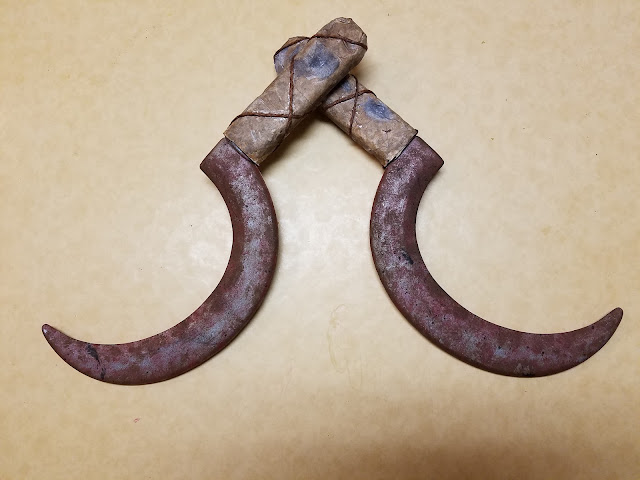Originally meant to be a companion piece for “The Fairy Thorn,” “The Fairy Well of Lagnanay” was published in the April 1833 issue of Blackwood’s Edinburgh Magazine as “The Fairy Well.” Along with the title change, the poem was riddled with spelling mistakes and lacked its companion piece. Understandably, all of these factors thoroughly upset author Samuel Ferguson, who later had it republished in 1846 under the correct title in Denis Florence McCarthy’s anthology Book of Irish Ballads.[1] In this tale, a heartbroken woman begs her sister to accompany her to the fairy well of Langnanay, where she longs to end her suffering and join Anna Grace (who disappears in “The Fairy Thorn”) among the fairies.
Mournfully, sing mournfully –
“O listen, Ellen, sister dear:
Is there no help at all for me,
But only ceaseless sigh and tear?
Why did not he who left me here,
With stolen hope steal memory?
O listen, Ellen, sister dear,
(Mournfully, sing mournfully) –
I’ll go away to Sleamish hill,
I’ll pluck the fairy hawthorn-tree,
And let the spirits work their will;
I care not if for good or ill,
So they but lay the memory
Which all my heart is haunting still!
(Mournfully, sing mournfully) –
The Fairies are a silent race,
And pale as lily flowers to see;
I care not for a blanched face,
For wandering in a dreaming place,
So I but banish memory: –
I wish I were with Anna Grace!
Mournfully, sing mournfully!
Hearken to my tale of woe –
‘Twas thus to weeping Ellen Con,
Her sister said in accents low,
Her only sister, Una bawn:
‘Twas in their bed before the dawn,
And Ellen answered sad and slow, –
“Oh Una, Una, be not drawn
(Hearken to my tale of woe) –
To this unholy grief I pray,
Which makes me sick at heart to know,
And I will help you if I may:
– The Fairy Well of Lagnanay –
Lie nearer me, I tremble so, –
Una, I’ve heard wise women say
(Hearken to my tale of woe) –
That if before the dews arise,
True maiden in its icy flow
With pure hand bathe her bosom thrice,
Three lady-brackens pluck likewise,
And three times round the fountain go,
She straight forgets her tears and sighs.”
Hearken to my tale of woe!
All, alas! and well-away!
“Oh, sister Ellen, sister sweet,
Come with me to the hill I pray,
And I will prove that blessed freet!”
They rose with soft and silent feet,
They left their mother where she lay,
Their mother and her care discreet,
(All, alas and well-away!)
And soon they reached the Fairy Well,
The mountain’s eye, clear, cold and grey,
Wide open in the dreary fell:
How long they stood ‘twere vain to tell,
At last upon the point of day,
Bawn Una bares her bosom’s swell,
(All, alas and well-away!)
Thrice o’er her shrinking breasts she laves
The gliding glance that will not stay
Of subtly-streaming fairy waves: –
And now the charm three brackens craves,
She plucks them in their fring’d array: –
Now round the well her fate she braves,
All, alas! and well-away!
Save us all from Fairy thrall!
Ellen sees her face the rim
Twice and thrice, and that is all--
Fount and hill and maiden swim
All together melting dim!
“Una! Una!” thou may’st call,
Sister sad! but lith or limb
(Save us all from Fairy thrall! )
Never again of Una bawn,
Where now she walks in dreamy hall,
Shall eye of mortal look upon!
Oh! can it be the guard was gone,
The better guard than shield or wall?
Who knows on earth save Jurlagh Daune?
(Save us all from Fairy thrall! )
Behold the banks are green and bare,
No pit is here wherein to fall:
Aye – at the fount you well may stare,
But nought save pebbles smooth is there,
And small straws twirling one and all.
Hie thee home, and be thy pray’r,
Save us all from Fairy thrall.[2]
Works Referenced
Campbell, Matthew. Irish Poetry Under the Union, 1801-1924. New York: Cambridge University Press, 2014.
Ferguson, Samuel. “The Fairy Well of Lagnanay.” The Poets and Poetry of Ireland with Historical and Critical Essays and Notes. Ed. Alfred Williams. Boston, MA: James Osgood and Company, 1881. 396-399.
____________________
[1] Campbell, 221.
[2] Ferguson, 396-399.






























